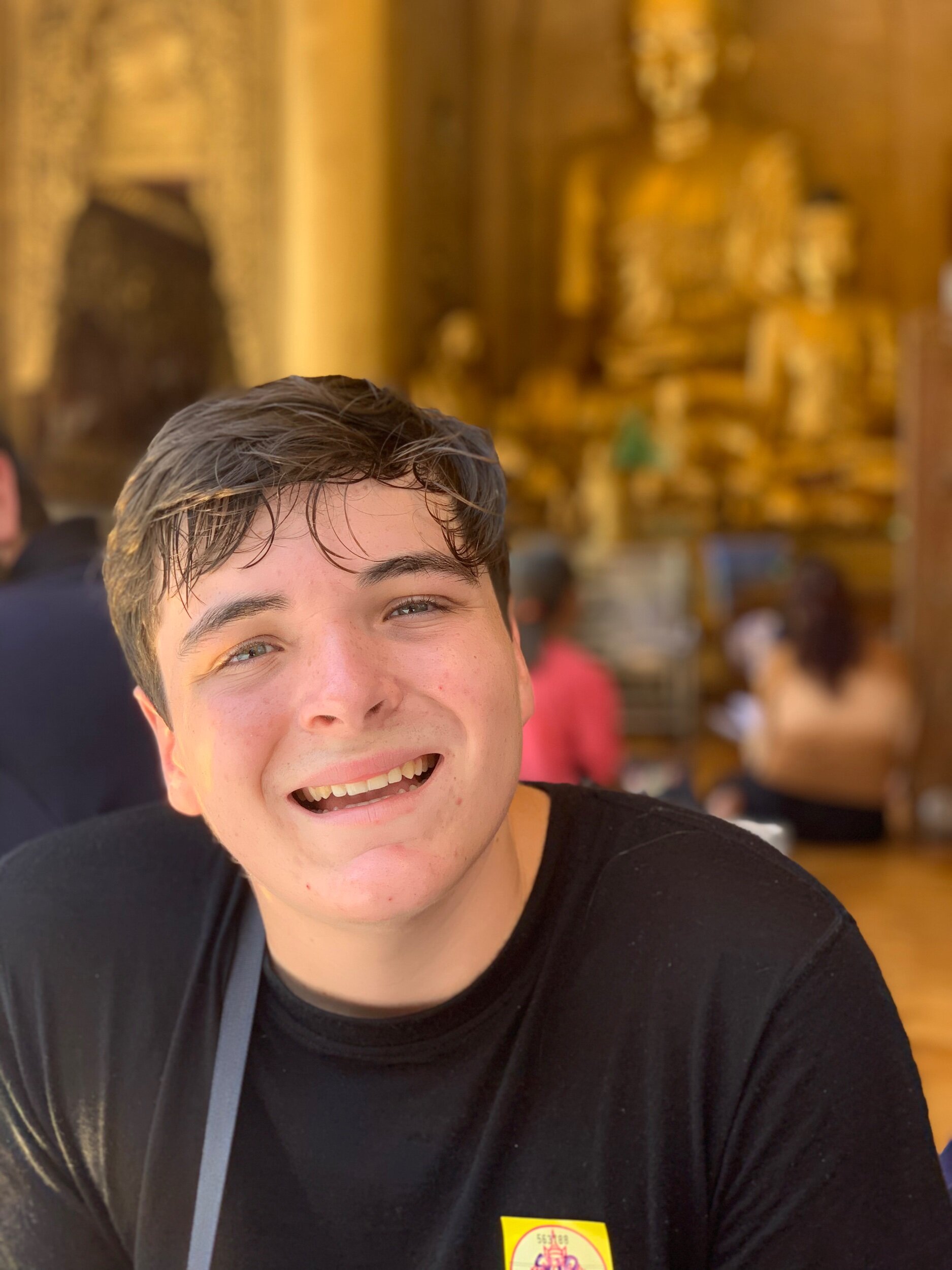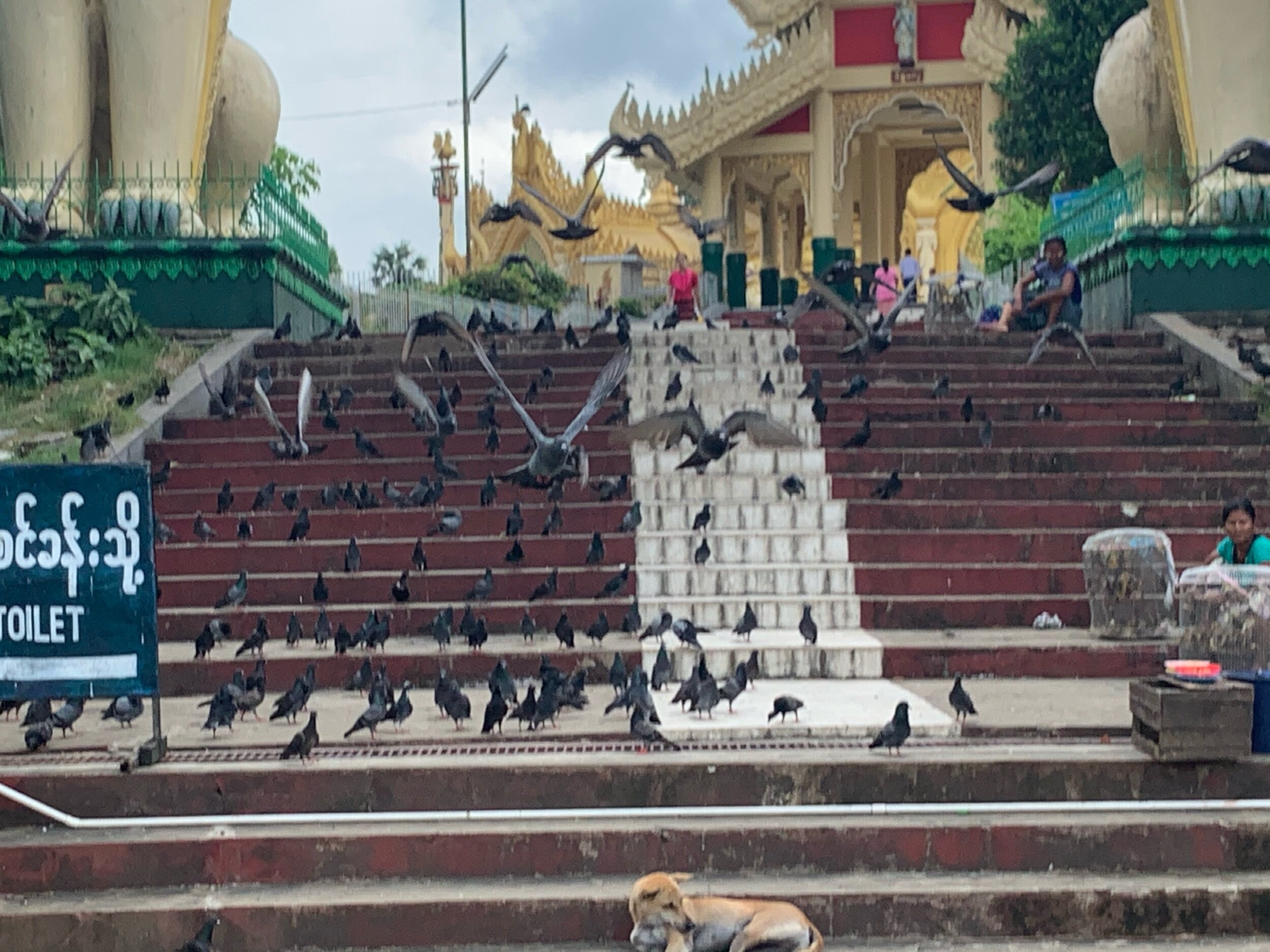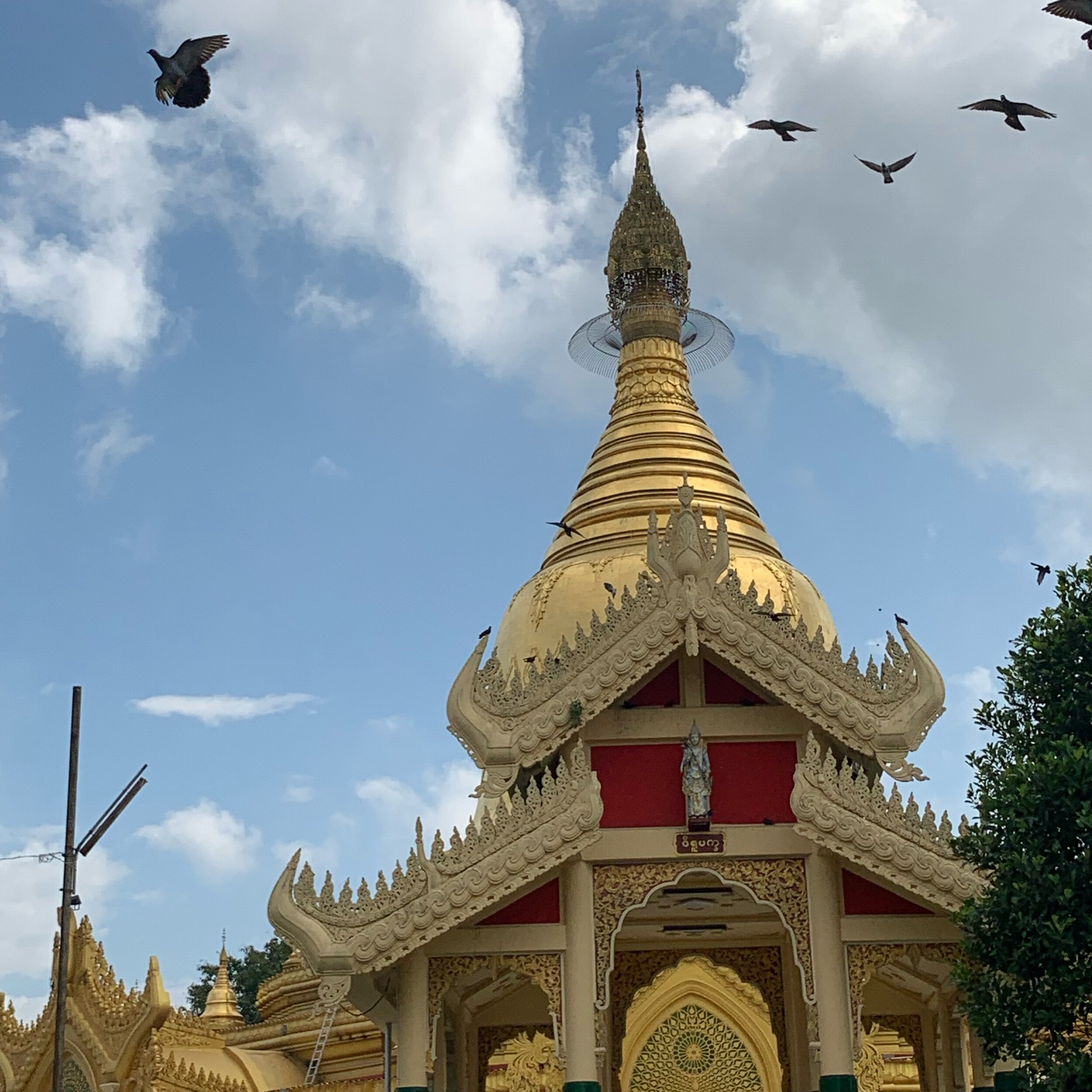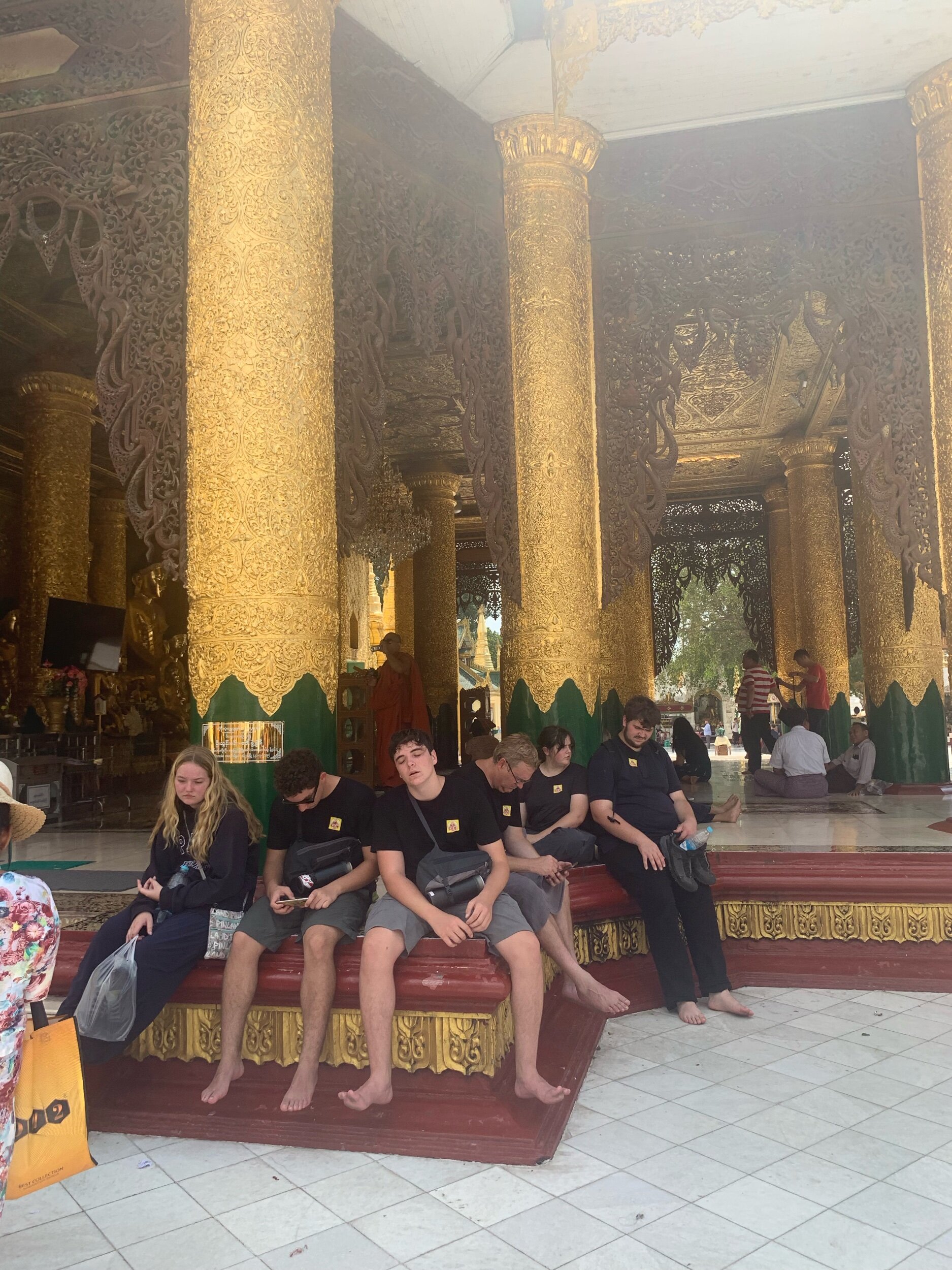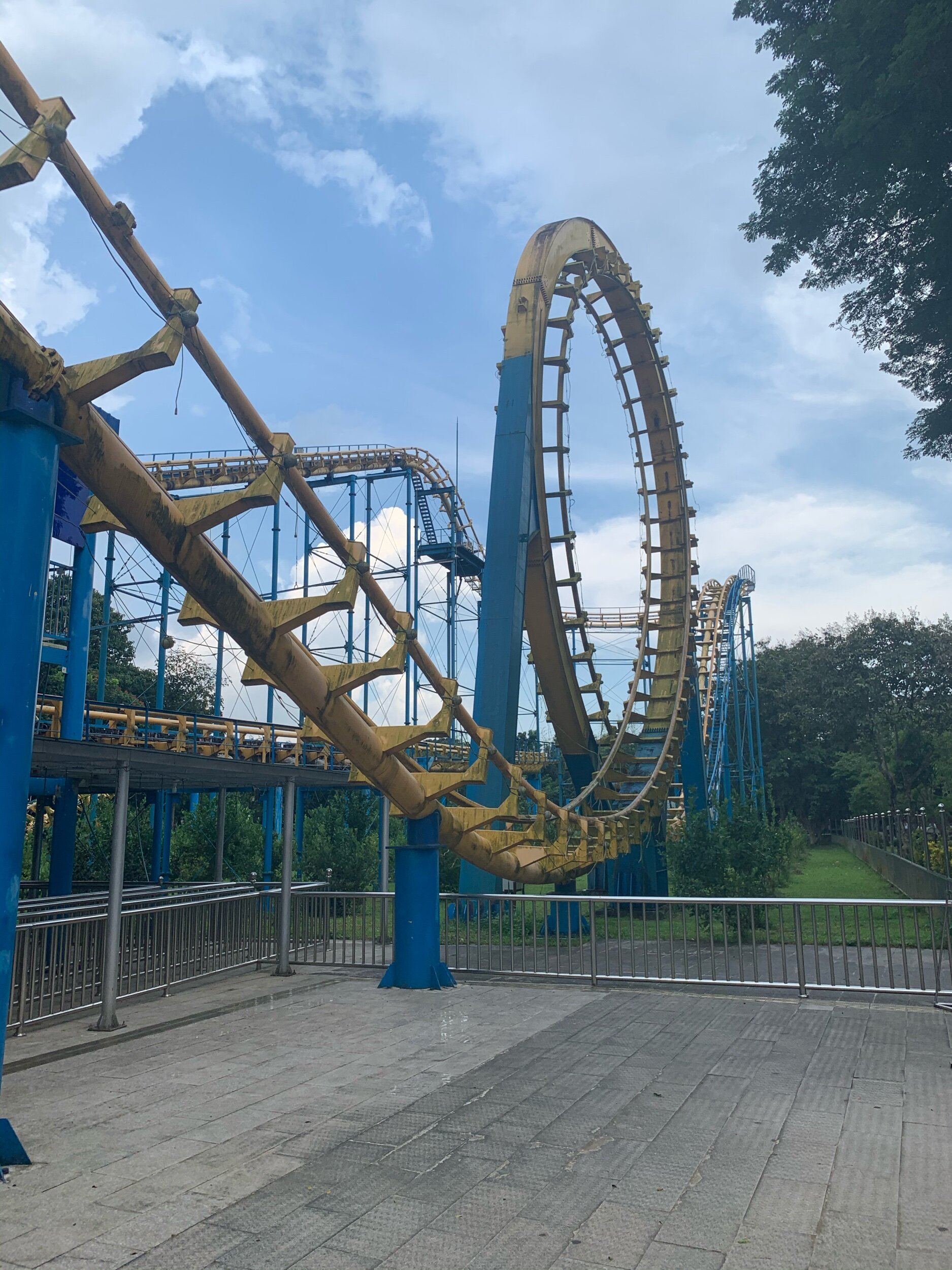11-5-19 - Big Sauce Tours and big heat
/Day 142. Kyle & Leanne joint blog. Yangon, Myanmar.
Big Sauce John wakes us all up for a 7:30am start to the Big Sause Tours day. We sojourn first to Easy Coffee Bar which sources its amazing coffee from award winning Small coffee producers in Myanmar. Leanne is thrilled to find avocado toast on the menu. The big Easy makes a mean bacon, egg and cheese sandwich although an hour and half later, it appears they are hand growing the ingredients for each and every sandwich. We read facts about Myanmar culture, history and religion. Six lattes later, we start walking. It’s only 9 am but it is hot and humid something fierce at a temperature of at least 90 degrees and humidity of a million percent.
First stop is Sien Yuang Chi Pagoda that resembles no other pagoda we’ve seen with its mirrored mosaic of scales covering the body of the Pagoda that glimmer and reflect the sunlight as if it’s covered in silver giving it the nickname the “Diamond Reflection.” This makes the pagoda look stunning during the day. The glass motif which adorns the building on the outside also extends inside the pagoda where several small and medium sized Buddha images keep a watchful eye. Inside the walls adorn thousands of 6 inches mini-Buddhas about the size of Barbie dolls. About 20 people are already there basking in scripture and prayer 🙏🏿. Some Buddha’s have neon lights radiating out from behind his head which combined with the exterior cause Kyle to dub it the “Las Vegas” Pagoda.
Next we visit Maha Vijaya Pagoda. The pagoda is a relatively recent one having been built in 1980. The enshrined relics were contributed by the King of Nepal while the pagoda's hti (umbrella) was consecrated by Ne Win, the country's former leader. The pagoda was built to commemorate the convening of the First Congregation of All Orders for the Purification, Perpetuation and Propagation of Sasana in 1980 which formed the State Sangha Maha Nayaka Committee a governmental regulatory body of Buddhist monks.
Upon the entrance, there was one seller that perplexed us. The woman says “buy bird, set free”. She’s sitting there with a large bird cafe with about 100 small birds frantically flying inside. It was clear her intention was to sell not for food but for release. “Oh my!” Leanne thought to herself, “how in the heck did this woman get that many birds into that small space?” Kyle points out that he thinks it’s a little bit of a stretch for the woman to take the birds hostage and expect innocent tourists to pay for their release as she would surely recapture the bird as soon as we leave. It’s not like we can take the bird with us on the rest of the trip. We add it to the list of “the most unusual stuff people around the world tried to sell us” which includes the high diver wiling to jump 15 meters into the toxic neon green pool in Agra and the prayer flags at the Tibetan mountaintop.
That yellow pagoda turned out to have a beautiful tree theme on the inside that gave you a sense that you were in the midst of a forest complete with bird tweeting sounds— kind of like a Buddhist-version of Rainforest Cafe. It also has murals throughout with paintings of pagodas from all over the country. Once again, inside many we’re praying on the day of the week — designated by the day of the week you are born.
Our next stop is the granddaddy of Pagodas, the Shwedagon Pagoda which is a Yangon treasure. The Shwedagon Pagoda aka Golden Dagon Pagoda is a 99 meter tall gilded stupa situated on Singuttara Hill to the west of Kandawgyi Lake and dominates the Yangon skyline. Shwedagon Pagoda is the most sacred Buddhist pagoda in Myanmar as it is believed to contain relics of the four previous Buddhas of the present kalpa. These relics include the staff of Kakusandha, the water filter of Koṇāgamana, a piece of the robe of Kassapa, and eight strands of hair from the head of Gautama.
Historians and archaeologists maintain that the pagoda was built by the Mon people between the 6th and 10th centuries AD. However, according to legend, the Shwedagon Pagoda was constructed more than 2,600 years ago, which would make it the oldest Buddhist stupa in the world. According to tradition, Tapussa and Bhallika — two merchant brothers from what is currently Yangon met the Lord Gautama Buddha during his lifetime and received eight of the Buddha's hairs. The brothers returned to Burma and, with the help of the local ruler, King Okkalapa, found Singuttara Hill, where relics of other Buddhas preceding Gautama Buddha had been enshrined.
The Shwedagon Pagoda Festival, which is the largest pagoda festival in the country, begins during the new moon of the month of Tabaung in the traditional Burmese calendar and continues until the full moon. The Pagoda has also been the site of many protests including 2007 when 30,000 people led by 15,000 Buddhist monks marched on the Pagoda in defiance of the military government.
As we explore the Pagoda, the heat and humidity is overwhelming and starts taking its toll on the group who’s pace now rivals the snails and turtles we saw in Thailand. Our rest breaks under the shade of an overhang become more and more frequent. There are designated areas around the pagoda displaying the days of the week at which you are supposed to visit the day of the week you were born on. We start with Monday planetary post and knock out three of us (Kyle, Justin & John). As we struggle to make it around the entire perimeter, we check off Leanne (Sunday), Ashlynn (Thurs), Corey (Fri). Former President Obama visited this Pagoda and the Friday planetary post. By the end, only Kyle, John and Ashley are still standing at the Tues corner to snap Ashley’s picture.
By now, Kyle is wavering between dehydration and heat stroke mumbling incoherent phrases about needing to find the Buddha and return his missing eight hairs. A number of bottles of water later (both ones drank and ones dumped over his head), he returns to land of the coherent having dispelled the notion of finding the Buddha from 2,600 years ago wondering amount the throngs of worshippers.
The clan exits the Pagoda duly impressed noting that this should definitely be a UNESCO site but conceding that Myanmar’s political situation likely results in a more difficult approval process than other countries.
We next head over to the People’s Park and People’s Square. The People's Park is located near the Western stairways of Shwedagon Pagoda. This park occupies over 130 acres between Shwedagon Pagoda and the Parliament building. People's Square occupies over 130 acres of land between Shwedagon Pagoda and Pyithu Hluttaw. Many National Events such as Independence Day. Union Day. National Day are held here. There is a beautiful fountain with white elephants.
We enter the park and immediately benefit from some well needed shade. The park is beautiful with bright green grass and lined with rows of fully developed trees. The first thing we come across is a decommissioned Myanmar Airlines airplane sitting at the end of a partial two land cement runway. Interesting as we can’t remember any other park where a commercial airplane is just plopped down in the middle of it. Next there is are three tree houses built around fully developed trees and connected by long swinging rope bridges. The kids take off to climb to the top of the tree house and traverse the “one can only hope it can hold the weight of multiple people” rickety bridge. Despite Leanne’s fear of heights, she surprises us and climbs to the top and makes her way across the bridge.
We then enter the square and witness the fountain with white elephants. From the signs around the park, it seems there is a water light show at the fountain at night but during the heat of the day, there is not even any water running. The entrance to the park had a picture of a roller coaster so some of the clan has become excited at the prospect and we head in that direction. We stop at the LOVE monument with giant stone letters spelling out the word for photos.
As we approach, we see the roller coaster arising from a field with overgrown weeds, plants and bushes. The yellow tracks that were once yellow have faded and peeled to leaving a mixture of black and yellow-brown color. Not seeing any visible signs of life, Kyle tells the kids, “well, looks like we are out of luck. I think the last time this coaster was operational was probably before I was born.” As if on cue, we hear a loud cranking, banging sound and a snake of eight coaster cars comes jerking and twitching out and up the first hill. “Holy crap, you’ve got to be kidding me that it actually works,” Kyle marvels.
Leanne asks, “ok, so who wants to go on this one?” Justin, Ashley and Ashlynn raise their hand while John starts listing off some of the likely dozens of safety violations they would be cited for in the US. Kyle says “first, I don’t want Justin to have to go alone and second, I think it will be safer if I’m with them.” Leanne is giving Kyle a look that says “and exactly how are you going to prevent that coaster thing from flying off the tracks?” Kyle is secretly psyched as he loves roller coasters. Kyle points out that none of the three people that just completed the ride died so they have a 100% safety record since we arrived.
Kyle and the three kids head off for their roller coaster ride which costs all of USD $0.80 – great deal if we don’t end up maimed or dead. As we sit down in the seat, the attendant first straps a seatbelt harness across our shoulders into a buckle. Next, he lowers the big, black padded shoulder device and clicks it in place. Third, he secures the padded should device via a strap to a manual buckle. I guess they are going with the philosophy that it’s highly likely one of the safety devices will fail, but as long as all three don’t fail at the same time, there is a good chance the passenger won’t die. Luckily, all four of us survive the roller coaster and exit to a relieved looking Leanne and John.
Having gotten our dose of fun, we exit the park / square and walk to the Yangon National Museum. The kids are super excited for the museum. Well, in truth they are more excited for the blasting air conditioning than the exhibits but we’ll take it. The museum’s first section traces the development of their language over time. The characters contain a lot of circles and squiggles.
Next we enter the throne room with the original Lion Throne from the eighteen hundreds. There were originally nine thrones with the Lion throne being the grandest. After the British took control of Burma, the Lion throne was moved to India in 1902. Turns out India did them a favor as the eight thrones that remained in Yangon (Rangoon at the time) were destroyed during WW II. In 1948, upon gaining independence, India returned the Lion throne to them. Definitely a Game of Thrones connection here with the Lannister Lion and giant throne.
One of our favorites was the natural history section of the museum that contained fossils and bones from prehistoric man and creatures. Bones from the Stegadon (predecessor to the Wooly Mammoth) were displayed. Stone tools and relics from Homo Erectus and Homo Sapiens were displayed along with the bones of an early humanoid skeleton all found in Myanmar.
By the time we finish, it’s 4pm, we’re exhausted having logged 18K steps and haven’t had lunch yet. We still need to replace the suitcase so we head so we decide to decide to the local mall which has the added benefit of having a Pizza Hut. There are some days we just need to the good old food from back home and this is one of them. We get the suitcase and load up on pizza making it linner. Back at the hotel, the rest of the day is nap, blog writing, schoolwork and chilling.











